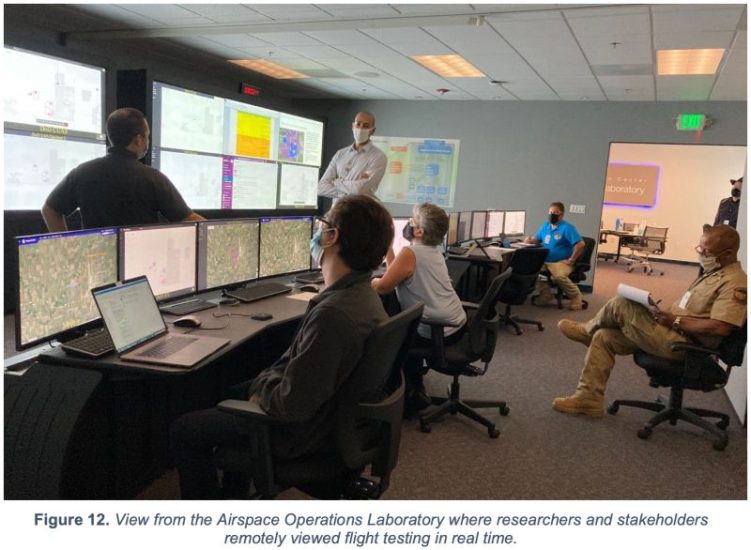The US National Aeronautics and Space Agency (NASA) Ames Research Center has published findings from evaluations carried out in 2021 relating to the application of Role-Based Access Control (RBAC) concepts to Uncrewed Traffic Management (UTM) in the context of Department of Defense (DoD) operations.
The evaluations were a collaborative effort involving government agencies supported by industry. Participants included: Northern Plains UAS Test Site; NASA Ames Research Lab including the Collaborative Low Altitude UAS Integration Effort (CLUE); and Simulyze in key testing roles.
The report, entitled Federal Unmanned Aircraft Systems Traffic Management: Concept and Joint Evaluation with the Department of Defense, examined concepts including: Allowing Air Traffic Control positions to communicate digitally with counter Uncrewed Aerial Systems (UAS) positions and flight personnel; all roles getting the data they need when they need it; every position developing a Common Operating Picture (COP) via shared data; and application of Discovery and Synchronization Service (DSS) concepts. Participants also examined concepts related to security agencies interacting with future commercial operations in a shared airspace, and how and when can the sides exchange data they need.
Security operations and gaps
Currently the DoD has Air Traffic Control (ATC), C-UAS, and UAS operators that operate on separate platforms. This structure has the potential to create a lag in communication and reduction in overall situational awareness and operational effectiveness. For example, a UAS operator in the field may have phone communication with ATC while the C-UAS operator has a separate direct line with ATC. Under such organization, by the time a C-UAS operator was able to detect a potential threat, communicate with ATC, who in turn would potentially get in touch with a friendly UAS crew, it could be too late before a threat was to intrude in protected airspace. This type of communications gap would be addressed through the implementation of a common platform for security users to communicate through and to build an awareness of the airspace situation based on shared information and access.
Activities conducted as part of the evaluations included:
- Tested 3 scenarios that allowed Federal operators to use UTM for their own flight planning, as well as design and integrate UTM into a Federal COP
- Created role-based access for Federal personnel, specifically for an Air Traffic Controller and Counter-UAS operator. These personnel were able to log into the Common operating picture and use the integrated UTM, C-UAS, and sensor data to inform decision making
- Tested messaging between Federal operators in the field and other personnel such as ATC, C-UAS, Manned pilots, and UAS crews
- Tested 3 categories of mission types: Non-Sensitive, Sensitive, and Sensitive Protected. Each type of mission would share or not share certain UTM data based on the type of mission.
Conclusions
The objective of this flight test was to determine the functions and features for a Federal USS. More specifically how a UTM COP can assist various users of a Federal USS and other integrated sources of data in decision making and communication. In this particular case, the focus was on interagency communication between UAS, ATC, and C-UAS operators. By creating a baseline FUSS and incorporating role-based access, the integration of C-UAS systems, and air traffic personnel, Federal operators can have better situational awareness and make faster, more optimal decisions. At the conclusion of the flight test, the following objectives were successfully demonstrated:
- ASTM Standard USS-to-USS communication
- Prototype Federal USS
- Role-based Access
- Interoperability messaging between operators
- Situational awareness for operators
- Common Operating Picture.
Based on the findings of this test and feedback from operators and stakeholders, NASA has recommended the following for future areas of research:
- Further develop the Common Operating Picture to include additional Federal partners
- Apply more usability research and incorporation of findings to further develop and refine the Common Operating Picture interface
- Continue the exploration of Operations Center requirements for complex operational environments to include displays, visualizations, communications methods, scalable integration of more sensors and data sources, etc.
- Inject manned operations into the scenario where operators can use a mobile device for situational awareness
- Add additional ecosystem features such as LAANC to integrate with a FUSS
- Expand the scope of research to integrate UTM, AAM, and ETM operations for a full capability demonstration
- Collaborate with additional Federal agencies to pursue a more comprehensive National Capitol Region scenario.
(Image: View from the Airspace Operations Laboratory where researchers and stakeholders remotely viewed flight testing in real time. NASA Ames)
Visit the report here
For more information visit:




